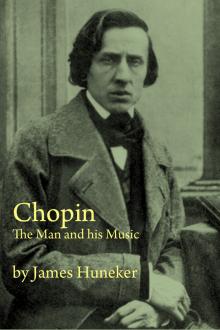Chopin: The Man and His Music, James Huneker [free e books to read online txt] 📗

- Author: James Huneker
- Performer: -
Book online «Chopin: The Man and His Music, James Huneker [free e books to read online txt] 📗». Author James Huneker
There is virile clangor in the firmly struck octaves of the opening pages. No hesitating, morbid view of life, but rank, harsh assertiveness, not untinged with splenetic anger. The chorale of the trio is admirably devised and carried out. Its piety is a bit of liturgical make-believe. The contrasts here are most artistic—sonorous harmonies set off by broken chords that deliciously tinkle. There is a coda of frenetic movement and the end is in major, a surprising conclusion when considering all that has gone before. Never to become the property of the profane, the C sharp minor Scherzo, notwithstanding its marked asperities and agitated moments, is a great work of art.
Without the inner freedom of its predecessor, it is more sober and self-contained than the B minor Scherzo.
The fourth Scherzo, op. 54, is in the key of E. Built up by a series of cunning touches and climaxes and without the mood depth or variety of its brethren, it is more truly a Scherzo than any of them. It has tripping lightness and there is sunshine imprisoned behind its open bars. Of it Schumann could not ask, “How is gravity to clothe itself if jest goes about in dark veils?” Here, then, is intellectual refinement and jesting of a superior sort. Niecks thinks it fragmentary. I find the fairylike measures delightful after the doleful mutterings of some of the other Scherzi. There is the same “spirit of opposition,” but of arrogance none. The C sharp minor theme is of lyric beauty, the coda with its scales, brilliant. It seems to be banned by classicists and Chopin worshippers alike. The agnostic attitude is not yet dead in the piano playing world.
Rubinstein most admired the first two Scherzi. The B minor has been criticised for being too much in the etude vein. But with all their shortcomings these compositions are without peer in the literature of the piano.
They were published and dedicated as follows: Op. 20, February, 1835, to M. T. Albrecht; op. 31, December, 1837, Comtesse de Furstenstein; op. 39, October, 1840, Adolph Gutmann, and op. 54, December, 1843, Mile, de Caraman. De Lenz relates that Chopin dedicated the C sharp minor Scherzo to his pupil Gutmann, because this giant, with a prize fighter’s fist, could “knock a hole in the table” with a certain chord for the left hand—sixth measure from the beginning—and adds quite naively: “Nothing more was ever heard of this Gutmann—he was a discovery of Chopin’s.” Chopin died in this same Gutmann’s arms, and, despite de Lenz, Gutmann was in evidence until his death as a “favorite pupil.”
And now we have reached the grandest—oh, banal and abused word—of Chopin’s compositions, the Fantaisie in F minor, op. 49. Robert Schumann, after remarking that the cosmopolitan must “sacrifice the small interests of the soil on which he was born,” notices that Chopin’s later works “begin to lose something of their especial Sarmatian physiognomy, to approach partly more nearly the universal ideal cultivated by the divine Greeks which we find again in Mozart.”
The F minor Fantaisie has hardly the Mozartian serenity, but parades a formal beauty—not disfigured by an excess of violence, either personal or patriotic, and its melodies, if restless by melancholy, are of surprising nobility and dramatic grandeur. Without including the Beethoven Sonatas, not strictly born of the instrument, I do not fear to maintain that this Fantaisie is one of the greatest of piano pieces.
Never properly appreciated by pianists, critics, or public, it is, after more than a half century of neglect, being understood at last. It was published November, 1843, and probably composed at Nohant, as a letter of the composer indicates. The dedication is to Princesse C. de Souzzo—these interminable countesses and princesses of Chopin! For Niecks, who could not at first discern its worth, it suggests a Titan in commotion. It is Titanic; the torso of some Faust-like dream, it is Chopin’s Faust. A macabre march, containing some dangerous dissonances, gravely ushers us to ascending staircases of triplets, only to precipitate us to the very abysses of the piano. That first subject, is it not almost as ethically puissant and passionate as Beethoven in his F minor Sonata? Chopin’s lack of tenaciousness is visible here.
Beethoven would have built a cathedral on such a foundational scheme, but Chopin, ever prodigal in his melody making, dashes impetuously to the A flat episode, that heroic love chant, erroneously marked dolce and played with the effeminacies of a salon. Three times does it resound in this strange Hall of Glancing Mirrors, yet not once should it be caressed. The bronze fingers of a Tausig are needed. Now are arching the triplets to the great, thrilling song, beginning in C
minor, and then the octaves, in contrary motion, split wide asunder the very earth. After terrific chordal reverberations there is the rapid retreat of vague armies, and once again is begun the ascent of the rolling triplets to inaccessible heights, and the first theme sounds in C minor. The modulation lifts to G flat, only to drop to abysmal depths. What mighty, desperate cause is being espoused? When peace is presaged in the key of B, is this the prize for which strive these agonized hosts? Is some forlorn princess locked behind these solemn, inaccessible bars? For a few moments there is contentment beyond all price. Then the warring tribe of triplets recommence, after clamorous G
flat octaves reeling from the stars to the sea of the first theme.
Another rush into D flat ensues, the song of C minor reappears in F
minor, and the miracle is repeated. Oracular octaves quake the cellarage of the palace, the warriors hurry by, their measured tramp is audible after they vanish, and the triplets obscure their retreat with chromatic vapors. Then an adagio in this fantastic old world tale—the curtain prepares to descend—a faint, sweet voice sings a short, appealing cadenza, and after billowing A flat arpeggios, soft, great hummocks of tone, two giant chords are sounded, and the Ballade of Love and War is over. Who conquers? Is the Lady with the Green Eyes and Moon White Face rescued? Or is all this a De Quincey’s Dream Fugue translated into tone—a sonorous, awesome vision? Like De Quincey, it suggests the apparition of the empire of fear, the fear that is secretly felt with dreams, wherein the spirit expands to the drummings of infinite space.
Alas! for the validity of subjective criticism. Franz Liszt told Vladimir de Pachmann the programme of the Fantaisie, as related to him by Chopin. At the close of one desperate, immemorial day, the pianist was crooning at the piano, his spirits vastly depressed. Suddenly came a knocking at his door, a Poe-like, sinister tapping, which he at once rhythmically echoed upon the keyboard, his phono-motor centre being unusually sensitive. The first two bars of the Fantaisie describe these rappings, just as the third and fourth stand for Chopin’s musical invitation, entrez, entrez! This is all repeated until the doors wide open swinging admit Liszt, George Sand, Madame Camille Pleyel nee Mock, and others. To the solemn measures of the march they enter, and range themselves about Chopin, who after the agitated triplets begins his complaint in the mysterious song in F minor. But Sand, with whom he has quarrelled, falls before him on her knees and pleads for pardon.
Straightway the chant merges into the appealing A flat section—this sends skyward my theory of its interpretation—and from C minor the current becomes more tempestuous until the climax is reached and to the second march the intruders rapidly vanish. The remainder of the work, with the exception of the Lento Sostenuto in B—where it is to be hoped Chopin’s perturbed soul finds momentary peace—is largely repetition and development. This far from ideal reading is an authoritative one, coming as it does from Chopin by way of Liszt. I console myself for its rather commonplace character with the notion that perhaps in the re-telling the story has caught some personal cadenzas of the two historians. In any case I shall cling to my own version.
The F minor Fantaisie will mean many things to many people. Chopin has never before maintained so artistically, so free from delirium, such a level of strong passion, mental power and exalted euphony. It is his largest canvas, and though there are no long-breathed periods such as in the B flat minor Scherzo, the phraseology is amply broad, without padding of paragraphs. The rapt interest is not relaxed until the final bar. This transcendental work more nearly approaches Beethoven in its unity, its formal rectitude and its brave economy of thematic material.
While few men have dared to unlock their hearts thus, Chopin is not so intimate here as in the mazurkas. But the pulse beats ardently in the tissues of this composition. As art for art, it is less perfect; the gain is on the human side. Nearing his end Chopin discerned, with ever widening, ever brighter vision, the great heart throb of the universe.
Master of his material, if not of his mortal tenement, he passionately strove to shape his dreams into abiding sounds. He did not always succeed, but his victories are the precious prizes of mankind. One is loath to believe that the echo of Chopin’s magic music can ever fall upon unheeding ears. He may become old-fashioned, but, like Mozart, he will remain eternally beautiful.
BIBLIOGRAPHYFrederic Chopin as a Man and Musician, by Frederick Niecks.
London, Novello, Ewer & Co.
Frederic Chopin, by Franz Liszt. London, W. Reeves.
Life and Letters of Frederic Chopin, by Moritz Karasowski, translated from the Russian by Emily Hill. London, W. Reeves.
Chopin and Other Musical Essays, by Henry T. Finck. New York, Charles Scribner’s Sons.
The Works of Frederic Chopin and their Proper Interpretation, by Jean Kleczynski, translated by A. Whittingham. London, W.
Reeves.
Chopin’s Greater Works, by Jean Kleczynski, translated with additions by Natalie Janotha. New York, Charles Scribner’s Sons.
Frederic Francois Chopin, by Charles Willeby. London, Sampson Low, Marston & Co.
Frederic Chopin, by Joseph Bennett. Novello, Ewer & Co.
F. Chopin, la Tradicion de su Musica, por Eduardo Gariel. City of Mexico, 1894.
Frederic Chopin, sa Vie et ses OEuvres, par Madame A. Audley.
Paris, E. Plon et Cie.
F. Chopin, Essai de Critique musicale, par H. Barbedette.
Friedrich Chopin und seine Werke, von Dr. J. Schucht. Leipzig, C. F. Kahnt.
Friedrich Chopin’s Leben und Werke, von A. Niggli. Leipzig, Breitkopf & Hartel.
Chopin, by Francis Hueffer, in Musical Studies. Edinburgh, A.
& C. Black.
Frederic Chopin, by W. H. Hadow, in Studies in Modern Music.
New York, Macmillan Co.
Frederic Chopin, by Louis Ehlert, in From the Tone World, translated by Helen D. Tretbar. New York.
Chopin, by W. de Lenz, from The Great Piano Virtuosos of our Time, translated by Madeleine R. Baker. New York, G. Schirmer.
Chopin, in Robert Schumann’s Music and Musicians, translated by Fanny Raymond Ritter. New York, Schuberth & Co.
Chopin, in Anton Rubinstein’s Conversation on Music, translated by Mrs. John P. Morgan. Steinway Hall: Charles F.
Tretbar, publisher.





Comments (0)